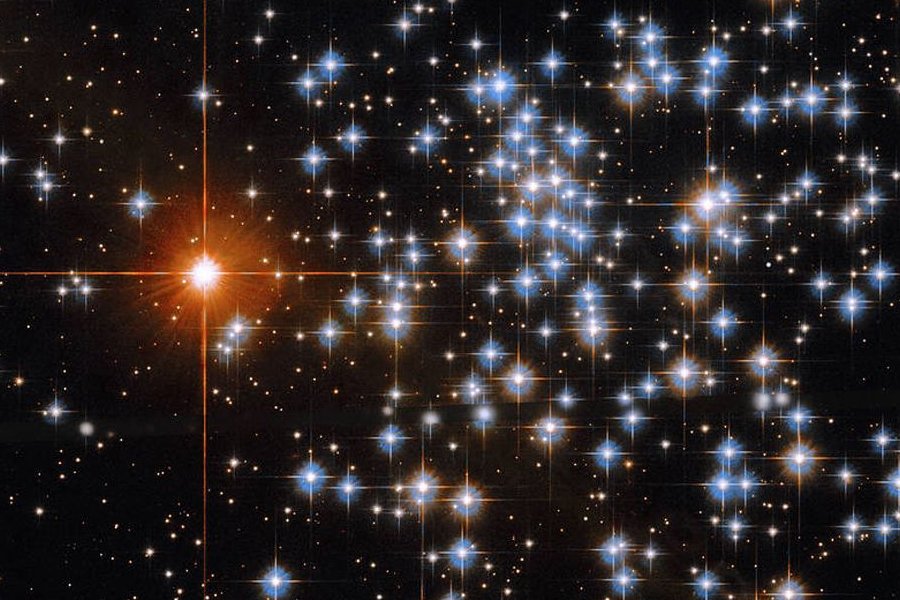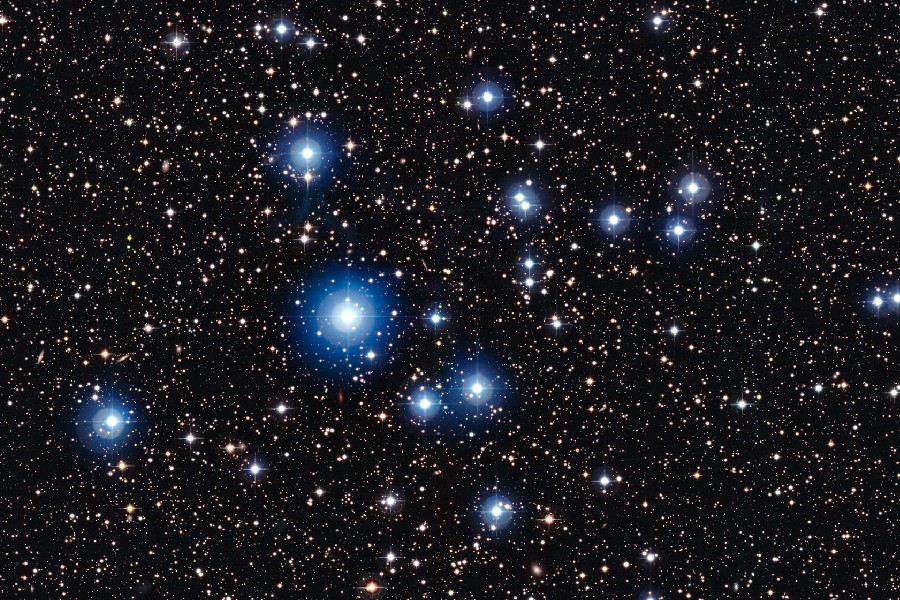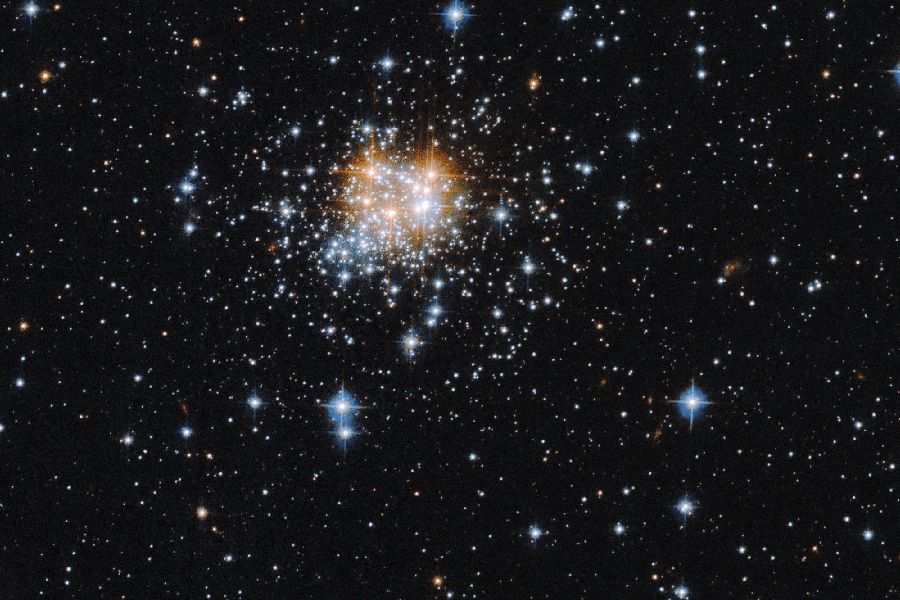Scattered across the night sky’s glittering tableau, tight knots of newborn stars can be spotted huddling together in cosmic nurseries. These stellar families, or open clusters, bound by gravity’s pull contain radiant young stars that formed together. But what are open clusters?
In this astronomy journey, we’ll overview the properties of stellar groupings called open star clusters and see why they intrigue astronomers. Learn how hot young member stars coalesce after birth and what blue-hued light they emit into the blackness.
We’ll also explore the full lifecycle of these clusters over eons. By the journey’s end, individuals will grasp how open star clusters form, evolve, and eventually dissipate across cosmic timescales.
What Are Open Clusters?
Open clusters are groups of stars loosely bound together by gravity. These clusters typically consist of relatively young stars formed from the same molecular cloud and share a common origin. The stars within an open cluster are often still surrounded by the remnants of the molecular cloud, which may manifest as faint nebulae or gas clouds.
Open clusters differ from globular clusters in size, age, and spatial distribution. They are usually found in the disk of a galaxy, such as the Milky Way. Their stars are spread out over a larger region than the more densely packed globular clusters.
Open clusters are dynamic systems, and gravitational interactions with other celestial bodies and the Galactic tidal forces can cause them to disperse over time. Due to their relative youth, open clusters are valuable for studying stellar evolution, as astronomers can observe stars of different masses and ages within the same cluster.

Properties of open clusters
Open clusters contain up to a few thousand stars loosely bound by gravity that all form together. But what are open star clusters, and what properties define these structures?
In an open cluster, members are scattered more diffusely across regions spanning light years rather than tightly packed. The shape also tends towards irregularity.
These open configurations reflect the residual gas clouds where members recently formed. The wispy remnants failed to strongly consolidate the cluster before dissipating over tens of millions of years after the burst of star formation.
Loose and dispersed configurations
In contrast to dense globular clusters, open clusters have more sparse distributions lacking a clearly defined spherical boundary. Their stars travel at similar velocities but with more eccentric local orbits.
Open clusters experience weaker gravitational forces holding member stars together. In addition, there are disruptive external tidal forces.
Over time, these two factors lead to the diffusion of open clusters. This grants them lifetimes spanning hundreds of millions of years before fully dispersing into surrounding galactic regions.
Comparison with globular clusters
Both globular and open clusters consist of gravitationally bound sets of stars. However, globular clusters differ greatly from open clusters in several major aspects.
Globulars have around a million times more mass and size. They also exhibit much higher stellar concentration and spherical symmetry due to stronger internal gravity forces.
An average globular cluster packs over a million members into a volume only dozens of light years across. More distant and ancient than open clusters, globulars hail mostly from early cosmic eras predating our Milky Way galaxy’s thin disk.
Exploration of different classifications
Age
Open clusters are categorized into young, intermediate-age, and old groupings based on member star ages deduced from color indices and spectral types.
Young open clusters contain hot, luminous blue stars less than 10 million years old, still associated with natal dust and nascent protostars arising in molecular clouds. Intermediate clusters house adolescent stars from 10 million up to 1 billion years old.
Size
Size classifications span small, medium and large open clusters based on the number of stars ranging from tens to several thousand members spread across just a couple to 20-30 light-years or more.
Diffuse clusters on the smaller end of this distribution feature sparser stellar concentrations. These are more vulnerable to disruptive tidal dissipation, limiting their lifespan before dispersing into surrounding galactic fields.
Stellar populations
Common open cluster classifications also include groupings based on chemical compositions and metal abundances of member stars used to trace ages and locations relative to galactic structures. These range from young metal-rich clusters in spiral arms to much older metal-poor halo residents.
In addition, open clusters contain representation across a wide range of star masses. This includes bright blue giants, searing hot main sequence stars, and faint, swollen red giants continuing to evolve.

Formation and structure
Open clusters emerge from giant molecular clouds of cold hydrogen gas and dust. They contract under self-gravity until dense cores light fusion, become protostars, and then blow away the remaining gases.
Most stars don’t have enough gravity to retain dispersing gasses. But subgroups stay bound as open clusters for hundreds of millions of years, drifting from dusty stellar nurseries over time.
Typical structural characteristics
Typically, open clusters span just a few dozen light years. They consist of a few hundred to a thousand gravitationally bound stars, all born with similar ages, chemical makeup, and movement through space.
Structure tends toward irregular contours rather than highly spherical. Over time, passing molecular clouds, close stellar encounters, and tidal forces work to disrupt the cluster.
Star formation in open clusters
Nearly every star is born within a stellar nursery – when a dense molecular cloud core collapses and fragments, it forms a new cluster of protostars. Powerful radiation emitted from the largest, hottest protostars can ionize any remaining gas from the cloud into glowing nebulae.
Young open clusters just starting to shine are still immersed in and interacting with these stellar nurseries they emerged from. Their massive young stars’ radiation can compress surrounding gas into new areas, stimulating another round of clustered star formation.
This propagating, self-perpetuating process means multiple generations of stars form in sequence. By around 5 million years old, clusters have cleared away their original cloud material.
The structure of open clusters
Open clusters have stars arranged in a dispersed manner, with each star separated by light years. They occupy an irregular volume, often spanning dozens of light years, and can contain several hundred to a few thousand gravitationally bound members.
Towards the outer edges of these clusters, the density decreases due to weaker gravitational cohesion. In these regions, stars are more prone to tidal disruption and can easily escape the cluster’s influence to join the surrounding galaxy.
Dynamics within the cluster
Stars within a cluster orbit its center, following diverse paths and velocities influenced by their mass and proximity to other stars. Kinetic energy is transferred during close gravitational encounters.
Over hundreds of millions of years, internal gravity and external tidal forces gradually relax the clusters, causing them to evolve into evenly dispersed, spherical distributions. Eventually, the increasing dispersion leads to the complete dissolution of the structure.
Location and distribution
What are open clusters locations? Open star clusters mostly reside within spiral galaxies’ disks. They concentrate along the galaxies‘ curving spiral arms.
The spiral arms contain density waves funneling in gas and dust. This influx of material fuels extensive star and cluster formation.
Proximity to star-forming regions
Most open clusters form near stellar nurseries within giant molecular clouds. These clouds collapse, giving birth to dense cores from which clusters emerge.
As the clouds break apart, they create diffuse stellar association groups. This process involves condensation at different densities throughout the clouds. These nurseries, where open clusters are born, are found near young stars and nebulae.

Where Are Open Clusters Found?
Associations with gas clouds
For around 10 million years after forming, open clusters remain embedded within their parent gas clouds. Eventually, radiation pushes from the largest young stars, and supernovae will expel these surrounding gasses. With the gas swept aside, mature open cluster members become openly exposed.
Positions within the Milky Way galaxy
The vast majority of open clusters inhabit the thin disk region of galaxies like our Milky Way. A minority reside in central bulge/halo areas. The most massive open clusters can persist there for billions of years.
More diffuse outer disk clusters succumb to disruptive tidal forces over hundreds of millions of years. They dissipate into the field star population when their gas-rich stellar nurseries are long gone.
Number and Distribution of Open Clusters in the Milky Way Galaxy
Current tallies estimate over 1,100 identified open clusters in the Milky Way, with the total likely exceeding many tens of thousands scattered across the Galactic disk and in the surrounding halo out to nearly 16,000 light years from the core.
Their abundance and diversity in age, size, stellar makeup/metallicity, and proximity to gas/dust complexes offer a detailed evolutionary timeline. This provides a chemical map of the interstellar matter born in Milky Way stellar nurseries over billions of years.
How Do Stars Evolve in an Open Cluster?
Influence of interactions and stellar dynamics
Member stars in an open cluster form together from the same cloud, so they all age at the same rate based on their mass. The most massive stars explode as supernovae within about 10 million years, while the smallest ones keep fusing for trillions of years.
Gravitational encounters happen often, and the cluster’s tidal forces constantly smooth out velocities, creating balanced distributions. These interactions affect binary systems, rotations, and accretion processes, which can significantly influence the evolution and lifespan of certain stars.
Examples of Notable Open Clusters
The Pleiades (M45)
The Pleiades star cluster, also known as Messier 45 (M45), is located around 440 light years away from Earth, making it one of the closest open clusters. It presents itself as a dazzling assembly of young, hot stars in the Taurus constellation.
Often referred to as the “Seven Sisters,” the Pleiades comprises numerous bright stars that probably originated together approximately 100 million years ago. These stars emerged from a cloudy stellar nursery formed within a giant molecular cloud, which has since disappeared.
Characteristics and significance of selected open clusters
The Wild Duck Cluster (M11) extends across 25 light years within a vibrant star-forming region near Scorpius’s tip. It features bright blue stars that are just 220 million years old, surrounded by red emission nebulae where new stars are born.
Situated near the constellation Cancer, the Beehive Cluster (M44) boasts a mass nearly five times that of the Pleiades. Estimates suggest its age is around 600 million years, making it one of the oldest nearby open clusters primarily hosting middle-aged stars.
Conclusion
What are open clusters? Open clusters are groups of stars formed from the same molecular cloud and loosely bound by gravity.
In our exploration of congregations of stars within galaxies, we unveiled both vibrant newborn clusters and seasoned ones that journeyed together for countless ages. We highlighted traits unique to open clusters, distinguishing them from their globular counterparts.
Understanding the complete life cycle over cosmic time represents the ongoing celestial circle of life. As we surveyed open star clusters scattered across our night sky, galaxy, and the vast universe, we aimed to enhance the appreciation of their splendor, making the experience even richer.
